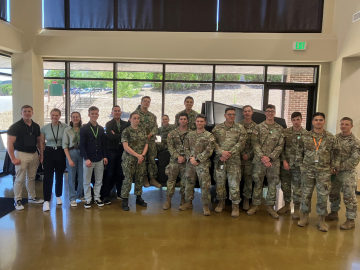
Filter News
Area of Research
- Advanced Manufacturing (22)
- Biology and Environment (56)
- Biology and Soft Matter (1)
- Building Technologies (1)
- Clean Energy (111)
- Climate and Environmental Systems (2)
- Computational Engineering (1)
- Computer Science (1)
- Electricity and Smart Grid (1)
- Fuel Cycle Science and Technology (1)
- Functional Materials for Energy (1)
- Fusion and Fission (11)
- Fusion Energy (8)
- Isotope Development and Production (1)
- Isotopes (26)
- Materials (74)
- Materials for Computing (8)
- Mathematics (1)
- National Security (51)
- Neutron Science (24)
- Nuclear Science and Technology (27)
- Nuclear Systems Modeling, Simulation and Validation (1)
- Quantum information Science (2)
- Supercomputing (66)
News Topics
- (-) 3-D Printing/Advanced Manufacturing (125)
- (-) Advanced Reactors (34)
- (-) Climate Change (103)
- (-) Cybersecurity (35)
- (-) Fossil Energy (6)
- (-) Frontier (44)
- (-) Isotopes (54)
- (-) Molten Salt (8)
- (-) National Security (68)
- (-) Physics (63)
- (-) Space Exploration (25)
- Artificial Intelligence (95)
- Big Data (58)
- Bioenergy (92)
- Biology (100)
- Biomedical (59)
- Biotechnology (23)
- Buildings (59)
- Chemical Sciences (69)
- Clean Water (30)
- Composites (29)
- Computer Science (194)
- Coronavirus (46)
- Critical Materials (29)
- Decarbonization (81)
- Education (4)
- Element Discovery (1)
- Emergency (2)
- Energy Storage (111)
- Environment (198)
- Exascale Computing (39)
- Fusion (55)
- Grid (65)
- High-Performance Computing (88)
- Hydropower (11)
- Irradiation (3)
- ITER (7)
- Machine Learning (48)
- Materials (145)
- Materials Science (144)
- Mathematics (9)
- Mercury (12)
- Microelectronics (4)
- Microscopy (51)
- Nanotechnology (60)
- Net Zero (14)
- Neutron Science (133)
- Nuclear Energy (110)
- Partnerships (49)
- Polymers (33)
- Quantum Computing (35)
- Quantum Science (70)
- Renewable Energy (2)
- Security (24)
- Simulation (49)
- Software (1)
- Statistics (3)
- Summit (59)
- Sustainable Energy (129)
- Transformational Challenge Reactor (7)
- Transportation (97)
Media Contacts

A study found that beaches with manmade fortifications recover more slowly from hurricanes than natural beaches, losing more sand and vegetation. The researchers used satellite images and light detection and ranging data, or LIDAR, to measure elevation changes and vegetation coverage. Changes in elevation showed how much sand was depleted during the storm and how much sand returned throughout the following year.

Researchers at ORNL have demonstrated that small molecular tweaks to surfaces can improve absorption technology for direct air capture of carbon dioxide. The team added a charged polymer layer to an amino acid solution, and then, through spectroscopy and simulation, found that the charged layer can hold amino acids at its surface.

Benjamin Manard, an analytical chemist in the Chemical Sciences Division of the Department of Energy’s Oak Ridge National Laboratory, will receive the 2024 Lester W. Strock Award from the Society of Applied Spectroscopy.

Ten future U.S. Army officers recently visited ORNL to learn about the legacy of nuclear science. As students of the Nuclear Science and Engineering Research Center, or NSERC, with the Defense Threat Reduction Agency, or DTRA, they stopped in East Tennessee as part of a larger tour across nuclear facilities supporting the military. In Oak Ridge, they visited ORNL to gain an appreciation of the history of the Manhattan Project and how research at a national lab contributes new materials and electronics for the nuclear industry.

Scientists have determined that a rare element found in some of the oldest solids in the solar system, such as meteorites, and previously thought to have been forged in supernova explosions, actually predate such cosmic events, challenging long-held theories about its origin.

Two additive manufacturing researchers from ORNL received prestigious awards from national organizations. Amy Elliott and Nadim Hmeidat, who both work in the Manufacturing Science Division, were recognized recently for their early career accomplishments.

The world’s fastest supercomputer helped researchers simulate synthesizing a material harder and tougher than a diamond — or any other substance on Earth. The study used Frontier to predict the likeliest strategy to synthesize such a material, thought to exist so far only within the interiors of giant exoplanets, or planets beyond our solar system.
Joe Tuccillo, a human geography research scientist, leads the UrbanPop project that uses census data to create synthetic populations. Using a Python software suite called Likeness on ORNL’s high-performance computers, Tuccillo’s team generates a population with individual ‘agents’ designed to represent people that interact with other agents, facilities and services in a simulated neighborhood.
The contract will be awarded to develop the newest high-performance computing system at the Oak Ridge Leadership Computing Facility.

Brittany Rodriguez never imagined she would pursue a science career at a Department of Energy national laboratory. However, after some encouraging words from her mother, input from key mentors at the University of Texas Rio Grande Valley, or UTRGV, and a lot of hard work, Rodriguez landed at DOE’s Manufacturing Demonstration Facility, or MDF, at Oak Ridge National Laboratory.


